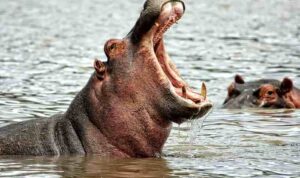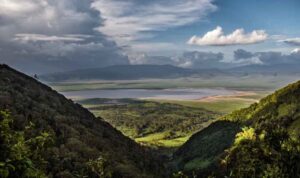Wildebeest, known for their incredible migration across the African plains, captivate with their unique physical traits and fascinating behavior in the wild. Explore the world of these majestic creatures as we delve into their lives and journeys.
From their distinctive appearance to their intricate social structures, Wildebeest offer a glimpse into the wonders of nature that are both awe-inspiring and captivating.
General Information: Wildebeest

Wildebeests, also known as gnus, are large antelopes known for their distinctive appearance and behavior in the wild. They are characterized by a large, robust body with a slightly sloping back, a long face, and curved horns. Their coat is a grayish-brown color with dark vertical stripes on the neck and shoulders.
Physical Characteristics
Wildebeests are commonly found in the grasslands, savannas, and open woodlands of eastern and southern Africa. They are known for their annual migration, where millions of individuals travel long distances in search of greener pastures. Wildebeests are herbivores, grazing on grasses and other vegetation. They are preyed upon by lions, hyenas, and crocodiles.
Behavior in the Wild, Wildebeest
In their natural habitat, wildebeests exhibit herding behavior, forming large groups that provide protection against predators. During the migration, they move in a coordinated manner, following established migration routes. Wildebeests are known for their distinctive “pronking” behavior, where they jump and kick their legs in the air, believed to be a way to communicate with other members of the herd.
Migration Patterns

Wildebeests are known for their remarkable annual migration patterns, where millions of individuals move across vast distances in search of greener pastures and water sources. This migration is essential for their survival and is influenced by various factors.
Reasons for Migration
Wildebeests migrate primarily in search of food and water. As herbivores, they rely on lush grasslands for sustenance, which become scarce during certain times of the year. By moving to different areas, wildebeests can ensure access to the resources they need to survive and reproduce.
- Migration also helps wildebeests escape predators, as moving in large herds makes it harder for predators to target individuals.
- The migration cycle is also linked to the reproductive cycle of wildebeests, with the availability of resources influencing breeding patterns.
Challenges Faced During Migration
The migration of wildebeests is not without its challenges. Despite their large numbers, wildebeests face various obstacles during their journey, including natural barriers, predators, and exhaustion.
- One of the most significant challenges is crossing rivers, where wildebeests risk encounters with crocodiles and swift currents.
- Predators such as lions and hyenas also pose a threat during the migration, targeting weaker individuals or calves.
- Exhaustion and lack of food can also impact wildebeests, especially during long journeys that require tremendous amounts of energy.
Predators and Defense Mechanisms

Wildebeests, despite their large numbers, are preyed upon by several predators in the African savannah. Some of the main predators of wildebeests include lions, hyenas, cheetahs, leopards, and crocodiles.
Defense Mechanisms of Wildebeests
Wildebeests have developed various defense mechanisms to protect themselves from predators. One of the most common defense tactics is their sheer numbers during migration, making it difficult for predators to target a single individual. Additionally, wildebeests are known for their speed and agility, enabling them to outrun predators in open grasslands. They also have keen senses of sight, smell, and hearing, helping them detect potential threats and evade danger. When faced with a predator, wildebeests may form a circle with the young calves in the center, using their sharp horns to ward off attacks.
Predator-Prey Dynamics
The predator-prey dynamics between wildebeests and their predators are a constant battle of survival in the African wilderness. While predators rely on stealth, strategy, and teamwork to hunt wildebeests, these herbivores have evolved to be vigilant, swift, and adaptable in order to escape becoming prey. The balance between predator and prey is crucial for maintaining the ecosystem’s health and biodiversity in the savannah.
Reproduction and Social Structure

Wildebeests, also known as gnus, exhibit interesting reproductive behavior and have a complex social structure within their herds.
Reproductive Behavior
Wildebeests are seasonal breeders, with mating typically occurring during the rainy season when food is abundant. During this time, males compete for the attention of females by displaying dominance through vocalizations, posturing, and physical combat. Once a male successfully mates with a female, gestation lasts around 8.5 months, after which a single calf is born. The mother will isolate herself from the herd to give birth and then rejoin the group shortly after.
Social Structure
Wildebeests are known for forming large herds consisting of hundreds to thousands of individuals. Within these herds, there is a hierarchical structure based on age and size, with dominant males leading the group. The herds are matriarchal, meaning that females play a crucial role in decision-making and leading the group to water and grazing areas.
Communication within the Herd
Wildebeests communicate with each other through various vocalizations, including grunts, snorts, and calls. These vocalizations help in coordinating movements within the herd, alerting others to potential dangers, and maintaining social bonds. Additionally, wildebeests use body language, such as head tossing and tail flicking, to convey messages and maintain cohesion within the group.
In conclusion, Wildebeest stand as a testament to the beauty and complexity of the natural world. Their migrations, interactions, and survival strategies paint a vivid picture of resilience and adaptability in the face of challenges. Witnessing these remarkable creatures in action is truly a sight to behold.






